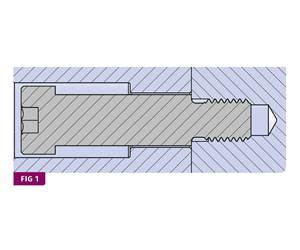How to Clean a Flashed Hot Manifold-Part One
As I rounded the corner of our shop, I was confronted by a large flock of white shirts gathered around a mold on my bench.
As I rounded the corner of our shop, I was confronted by a large flock of white shirts gathered around a mold on my bench. They stepped aside so that I could see what all the fuss was about. A blob of styrene poking out from the wires of the opened electrical box attested to a thoroughly flashed manifold.
I silently hung up my coat and headed for the coffee pot. I would need plenty of coffee. The tedious task ahead of me, according to the verbiage in the maintenance manual, would be to “carefully remove the plastic via an appropriately sized hammer and brass chisel, taking extreme precautions to not damage any surrounding wires, heaters, or electrical connections.” In the real world, we call it “chippin’ and rippin’.”
Dirty job
The above scenario is played out hundreds of times in plastics plants each day. It is one of the most dreaded mold-maintenance jobs. The boredom of chipping plastic is only occasionally relieved by the anxiety of discovering wires cut through or manifold heater connections chopped off from an errant stroke of the chisel. The task also requires a face mask, heat gun, awkward gloves, an affinity for the stench of burnt plastic, and truckloads of patience.
I have spent hundreds of hours chipping and cleaning manifolds of 16- to 48-cavity molds with various types of manifold systems. Some may flash easier than others, but none is immune to flashing caused by a hurried start-up by an impatient molder or caused by bolts left loose by a preoccupied repair tech. No particular brand of manifold cleans up more quickly or easily than any other. But every flashed system seems to attract a number of white shirts clamoring for a super-quick turnaround, with no apparent clue as to what the job entails.
After the dirty work is done, it will test the skills of the most seasoned craftsman to perform the precise measurements necessary to determine if combined tooling tolerances (stack-out) are enough to have contributed to the leak. Measuring mold components to within 0.0001 in. while referencing non-perfect surfaces is a time-consuming task requiring calibrated instruments, a surgeon’s touch, and excellent analytical skills. It is the part of the troubleshooting process that separates a journeyman from, well, everyone else.
What were they thinking?
I once attended a seminar where the guest speaker was a hot-runner specialist who thanked us in the audience for our continued support of his children’s college fund through our steady tendency to encapsulate manifold wiring and other delicate components with flash. When asked reasons for these flashing follies, he cited these causes in order of frequency:
- Manifolds left on over weekends. Many older presses will not power down the heaters when the press is shut off, so manifolds are left to cook. This accomplishes two things: The overheated plastic de grades and drops significantly in viscosity, causing resin weepage into tooling clearances. Second, the tooling overheats, causing it to expand and hob the sealing surfaces, reducing the manifold’s ability to seal itself when the temperature is brought back down into proper range.
- Cold starts. His college fund loves impatient molders who don’t allow manifolds adequate “soak” time of 20 to 40 min to allow the steel to fully expand and create the necessary sealing pressure between components.
- Bad processing habits. Failing to reduce shot size after blocking cavities, not using backpressure when filling empty manifolds, running temperatures too high, reversing valve-pin sequence, and forgetting to turn on the cooling water are just a few deadly sins that contribute to leaking systems.
- Lack of preventive maintenance. Worn valve pins and bushings are common in manifolds that are overdue for a thorough going over. Also lethal are hobbed manifolds, spacers, and other tooling whose combined di men sions are under the recommended cold stack height. Other culprits are stressed or stretched bolts and fatigued compression-seal washers.
- Short cuts. Too often, in-house manifold cleanings are attempted by personnel who, for the sake of speed and dollars (or due to inexperience), try short cuts like partial disassembly and cleaning, or they fail to assemble the manifold correctly. It takes only a small mistake, such as a bolt that is not properly torqued or a probe skirt not fully seated, to create a clearance that allows melt to leak.
- Cracked tooling. Manifolds, probes, sprues, and crossover bars/ bridges can develop small fractures that turn into major cracks under injection pressure.
- Bad design. When shopping for a hot-runner system, it would be great to inspect one that has run a few million cycles—but you don’t see these at trade shows. Too bad.
Cleaning in-house
When hot-runner systems leak, experience and skilled technique should never be compromised for the delusion of a quick turnaround. The only thing that draws white shirts into the toolroom faster than a leaking manifold is one that leaks immediately after a rebuild.
The attraction of cleaning a flash-encapsulated system in-house rather than sending it out is the expectation of faster turnaround and lower cost. An experienced technician can chip, clean, partially rewire, and reassemble a 16-cavity valve-gate manifold of average complexity (such as a cap mold) that is completely flashed in about 30 hr, providing he/she has a heat gun, ultrasonic cleaning tank, appropriate music, and lots of coffee.
Multiply these hours by your fringe labor costs and possibly add in a couple of replacement heaters or thermocouples and you can easily invest $1500 to $2000 in the job. But the big advantage is that if you have experienced techs available around the clock, then you only lose about a day and a half of production. That is roughly the time it takes to crate and ship the mold to an outside vendor and is the number-one reason why many cleanings are first attempted in-house.
Should you go outside?
An outside vendor will not bother with the chip-and-rip, but instead will place the manifold in a high-temperature chamber to burn off the flashed plastic. The tooling emerges from the oven or fluidized sand bath super-clean with no plastic residue to throw off stacking measurements.
This method is less damaging to tooling than hand cleaning—no dings and burrs—and you get the added benefit of having the manifold, bridges, probe bodies, and sprues cleaned internally as well as on the outside. Some vendors also can check tooling for small cracks with digital imaging. Having an outside vendor handle the cleaning job also shifts the burden of accountability onto that firm’s shoulders.
So consider these criteria before deciding whether or not to send a leaker out for repair/rebuild or to attempt this delicate job in-house:
- In-house experience: If you don’t have personnel with hot-runner experience, you don’t want to train a new or inexperienced tech in manifold maintenance on a flash-encapsulated system that is badly needed back in production, unless the tech is assisting a capable journeyman. Minimizing component damage while chipping away flash requires at least an idea of where the wires and heater or thermocouple connections are located and how they are routed. Discovering these by whacking the chisel with a hammer to “see what you hit” is not advisable.
- Cost and turnaround time: During resin burnoff by an outside vendor, thermocouples and some heaters may be cooked to death, which raises the overall cost and rewiring and assembly time. So unless the vendor is right next door, total turnaround time is at least double what you could expect if repairs were done in-house. So now the job costs $3000 to $4000 and turnaround time is 4 to 5 days, minimum.
- Availability of replacement tooling: A common mistake is to begin the chip-and-rip without first verifying that you have several spare heaters, thermocouples, seals, and bolts on hand. Verify that the part numbers are correct and actually get the parts out of stock before you begin. I never trust storeroom balance-on-hand (BOH) figures.
If you have to stop and order parts, or send parts out for repair in the middle of a cleaning, then all your hustle has been for nothing because you now face a week-long turnaround.
- Current production requirement: Double-check what’s really essential before you begin a frantic teardown. If a couple of days and another couple of thousand dollars won’t matter that much, then it’s a good idea to send the tool or manifold outside for a thorough going-over, especially if you are not sure why the manifold flashed in the first place. (See p. 55 for more reasons to send a mold out or clean it in-house.)
If you do decide to send the work out, always visit the vendor first to get a feel for its manifold repair experience. Take a walk around the benches and observe the following:
Are blueprints, component listings, micrometers, and other measuring tools mixed in with cleaning tools like Scotchbrite, sandpaper, solvents, files, and stones?
On wired-up manifolds, are the wires numbered and routed cleanly with appropriate length? Or is excess wire rolled up and shoved into the electric box? Are there an appropriate number of clips (every 6 in.) holding the wires in the channels?
Unsatisfactory answers to these questions could indicate inexperience at the bench and a disorganized maintenance process that is prone to mistakes.
Next month we will go through the steps of a typical clean-and-rebuild for a flash-encapsulated system.
Steven Johnson worked as a toolmaker for 26 years, rebuilding and repairing multicavity molds for Calmar Inc. and then as mold-maintenance engineer for Hospira Inc., a medical device manufacturer. Today, he is the maintenance systems manager for Progressive Components and has his own business, MoldTrax in Ashland, Ohio, which designs and sells software for managing mold maintenance (www.moldtrax.com). He can be reached at steve@moldtrax.com or (419) 289-0281.
Related Content
How to Select the Right Tool Steel for Mold Cavities
With cavity steel or alloy selection there are many variables that can dictate the best option.
Read MoreWhere and How to Vent Injection Molds: Part 3
Questioning several “rules of thumb” about venting injection molds.
Read MoreWhy Shoulder Bolts Are Too Important to Ignore (Part 2)
Follow these tips and tricks for a better design.
Read MoreTunnel Gates for Mold Designers, Part 1
Of all the gate types, tunnel gates are the most misunderstood. Here’s what you need to know to choose the best design for your application.
Read MoreRead Next
Troubleshooting Screw and Barrel Wear in Extrusion
Extruder screws and barrels will wear over time. If you are seeing a reduction in specific rate and higher discharge temperatures, wear is the likely culprit.
Read MoreUnderstanding Melting in Single-Screw Extruders
You can better visualize the melting process by “flipping” the observation point so that the barrel appears to be turning clockwise around a stationary screw.
Read MoreWhy (and What) You Need to Dry
Other than polyolefins, almost every other polymer exhibits some level of polarity and therefore can absorb a certain amount of moisture from the atmosphere. Here’s a look at some of these materials, and what needs to be done to dry them.
Read More





























